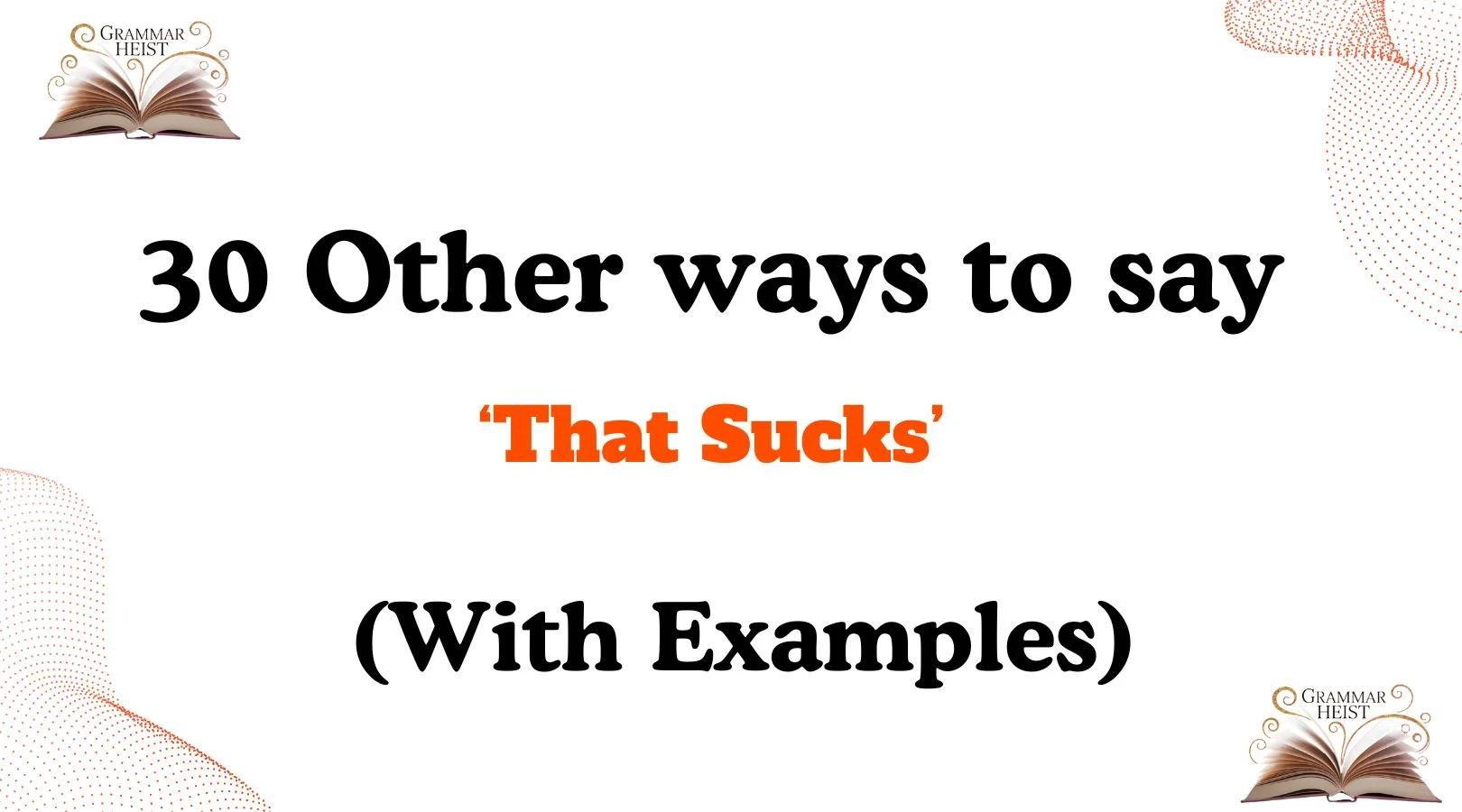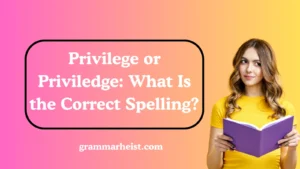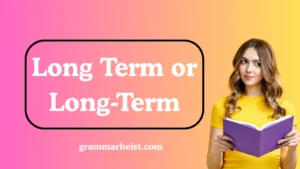Sometimes, words matter more than we think. Saying “that sucks” can express sympathy, but there are many other ways to communicate care, understanding, and empathy. Choosing the right alternative can make your message feel more personal, thoughtful, and meaningful. Whether you’re comforting a friend, responding to a colleague, or showing concern to a loved one, these alternatives will help you express yourself with warmth and authenticity.
What Does “That Sucks” Mean?
The phrase “that sucks” is a casual way of expressing disappointment, frustration, or sympathy for a negative situation. It’s commonly used in informal conversations, but sometimes you might want a more thoughtful, empathetic, or professional alternative.
Is It Professional/Polite to Say “That Sucks”?
While “that sucks” is widely understood, it’s not always considered professional or polite, especially in workplace or formal contexts. Using alternatives can help convey compassion without sounding casual or dismissive, making your words more versatile and effective.
Pros and Cons
Pros: Quick, easy to use, clearly expresses frustration or disappointment. Cons: Can sound casual or insensitive, especially in professional or sensitive situations. Using thoughtful alternatives shows more empathy and care.
Synonyms & Alternatives for “That Sucks”
- “That’s unfortunate.”
- “That’s really tough.”
- “I’m sorry to hear that.”
- “That must be frustrating.”
- “That’s such a shame.”
How to Say It in Different Ways
- Empathetic: “That sounds really difficult — I’m so sorry.”
- Supportive: “That’s rough. I’m here if you need to talk.”
- Professional: “That’s unfortunate. Let’s see how we can fix it.”
- Casual: “Man, that really stinks.”
- Friendly: “Ugh, that’s the worst — hang in there.”
Professional Ways to Say “That Sucks”
- “I understand that must be disappointing.”
- “That’s unfortunate. I’ll do my best to help resolve it.”
- “I can see why that would be frustrating.”
- “I’m sorry that happened — let’s look for a solution.”
- “That situation sounds challenging.”
Formal Ways to Say “That Sucks”
- “I regret to hear about your experience.”
- “That’s a rather unfortunate circumstance.”
- “Please accept my sympathy regarding that situation.”
- “It’s disheartening to learn of this outcome.”
- “I empathize with your disappointment.”
Informal Ways to Say “That Sucks”
- “That’s rough.”
- “Bummer, dude.”
- “Man, that’s the worst!”
- “Ugh, that’s so annoying.”
- “Total letdown.”
What “That Sucks” Means
- It expresses sympathy or shared frustration with someone’s situation.
- Used casually to acknowledge that something bad happened.
- Shows understanding and emotional connection.
- Helps make the other person feel heard and validated.
- Tone varies from lighthearted to genuinely empathetic, depending on context.
How to Respond to “That Sucks”
- “Yeah, it really does — thanks for understanding.”
- “I know, right? It’s been a rough day.”
- “Thanks, I appreciate you saying that.”
- “Hopefully things get better soon.”
- “It’s okay — I’ll bounce back.”
Synonyms For “That Sucks”
- That’s Unfortunate
- That’s Tough
- That’s a Bummer
- I’m Sorry to Hear That
- That’s Rough
- I Feel for You
- That’s Disappointing
- That Must Be Hard
- Ouch, That Hurts
- That’s Not Fun
- That Stinks
- That’s a Shame
- What a Drag
- That’s Rough Luck
- That’s a Blow
- That’s Rough Going
- That’s Crummy
- That’s a Setback
- That’s Frustrating
- That’s a Tough Break
- That’s a Drag
- That’s Heartbreaking
- That’s Awful
- That’s Rough on You
- That’s Unlucky
- That’s a Downer
- That’s Frustrating to Hear
- That’s a Misfortune
- That’s a Nasty Situation
- That’s Disheartening
1. That’s Unfortunate
Scenario: When someone shares disappointing news.
Examples:
- “Oh no, that’s unfortunate. I hope things get better soon.”
- “That’s really unfortunate. Let me know if I can help.”
- “I’m sorry to hear that. That’s quite unfortunate.”
Tone: Polite and gentle, shows consideration for the person’s feelings.
Explanation: This phrase communicates empathy without being overly casual. It lets someone know you acknowledge their situation while keeping the conversation respectful.
2. That’s Tough
Scenario: When someone is facing a challenging situation.
Examples:
- “That’s tough, I can imagine how you feel.”
- “I know that’s tough, stay strong.”
- “It sounds tough. Do you want to talk about it?”
Tone: Supportive and understanding, like a friend who genuinely cares.
Explanation: “That’s tough” signals sympathy and gives room for the person to share more. It’s simple yet shows you’re present and attentive.
3. That’s a Bummer
Scenario: Casual disappointment among friends or peers.
Examples:
- “Oh, that’s a bummer. I wish it went differently.”
- “That’s a total bummer, hope your day gets better.”
- “Yeah, that’s a bummer, but we’ll figure it out.”
Tone: Light and casual, friendly without being dismissive.
Explanation: Perfect for informal situations. It acknowledges the problem while keeping the vibe relaxed, so the person doesn’t feel judged or overwhelmed.
4. I’m Sorry to Hear That
Scenario: Someone shares sad or disappointing news.
Examples:
- “I’m sorry to hear that, it must be hard.”
- “That’s upsetting. I’m really sorry to hear that.”
- “I’m sorry to hear that. If you want to talk, I’m here.”
Tone: Compassionate and caring, conveys genuine concern.
Explanation: This is a classic empathetic response that works in nearly every context. It emphasizes listening and emotional support.
5. That’s Rough
Scenario: When someone experiences a setback or difficult situation.
Examples:
- “Wow, that’s rough. How are you holding up?”
- “That’s a rough day. Take it easy.”
- “Yeah, that sounds rough. I hope things improve soon.”
Tone: Empathetic and casual, like a supportive peer.
Explanation: “That’s rough” communicates understanding without overcomplicating things. It validates feelings while staying approachable.
6. I Feel for You
Scenario: When someone shares a frustrating or upsetting experience.
Examples:
- “I really feel for you. That must be hard.”
- “I can feel what you’re going through, it’s not easy.”
- “I totally feel for you, hang in there.”
Tone: Warm and sincere, emphasizes shared understanding.
Explanation: This phrase shows emotional connection. It’s gentle, compassionate, and makes the listener feel truly heard.
7. That’s Disappointing
Scenario: When plans don’t go as expected.
Examples:
- “That’s disappointing. I know you were looking forward to it.”
- “Yeah, that’s disappointing. Hopefully, the next one will be better.”
- “I understand why that’s disappointing, it’s frustrating.”
Tone: Respectful and thoughtful, professional-friendly.
Explanation: A slightly more formal alternative, “that’s disappointing” acknowledges the setback without sounding casual or insensitive.
8. That Must Be Hard
Scenario: When someone is going through a challenging situation.
Examples:
- “That must be hard. I admire your strength.”
- “It sounds like that must be hard for you.”
- “I can’t imagine, that must be really hard.”
Tone: Gentle and empathetic, showing awareness of their struggle.
Explanation: This response validates the person’s emotions while avoiding assumptions. It’s supportive and encouraging.
9. Ouch, That Hurts
Scenario: For setbacks or unfortunate events, slightly informal.
Examples:
- “Ouch, that hurts. I hope it gets better soon.”
- “Yeah, ouch, that’s not fun at all.”
- “Ouch, that must sting. Hang in there.”
Tone: Informal but sympathetic, often used among friends.
Explanation: Adds a touch of personality while acknowledging discomfort. It’s light-hearted but still caring.
10. That’s Not Fun
Scenario: Minor disappointments or irritating situations.
Examples:
- “That’s not fun at all. I’m sorry that happened.”
- “Yeah, that’s definitely not fun.”
- “That’s not fun, but we’ll figure it out together.”
Tone: Casual, friendly, and relatable.
Explanation: This phrase is simple and expresses solidarity without exaggeration. Perfect for everyday situations.
11. That Stinks
Scenario: When something unpleasant or frustrating happens.
Examples:
- “That stinks! I’m sorry you have to deal with that.”
- “Ugh, that really stinks. Hope it gets better soon.”
- “Yeah, that stinks. Let me know if I can help.”
Tone: Casual and sympathetic, friendly in informal settings.
Explanation: “That stinks” communicates frustration or disappointment while keeping a light, approachable vibe. It works well in everyday conversations.
12. That’s a Shame
Scenario: When someone misses out on something or faces a setback.
Examples:
- “That’s a shame, I know you were excited about it.”
- “It’s a shame that didn’t work out as planned.”
- “Yeah, that’s a shame. Hopefully, there will be another chance.”
Tone: Thoughtful and gentle, conveys genuine concern.
Explanation: This phrase expresses regret over a situation while being polite and empathetic. It’s versatile and slightly more formal than “that sucks.”
13. What a Drag
Scenario: For annoying or inconvenient situations.
Examples:
- “What a drag! I hate when that happens.”
- “Yeah, that’s a drag, hope it gets sorted soon.”
- “What a drag! Let’s see how we can make it easier.”
Tone: Informal, conversational, relatable.
Explanation: “What a drag” shows shared frustration without being harsh. It makes the listener feel understood in casual settings.
14. That’s Rough Luck
Scenario: When misfortune strikes unexpectedly.
Examples:
- “That’s rough luck, I’m sorry it happened.”
- “Wow, that’s rough luck, hope it turns around soon.”
- “Yeah, that’s rough luck. Things will get better.”
Tone: Empathetic and slightly old-fashioned, gentle.
Explanation: Highlights the unfortunate nature of the situation without blaming anyone. Perfect for showing sympathy while remaining polite.
15. That’s a Blow
Scenario: For sudden setbacks or disappointments.
Examples:
- “That’s a blow! I hope it doesn’t affect you too much.”
- “Wow, that’s a real blow. Hang in there.”
- “That’s a blow, but you’ll get through it.”
Tone: Serious yet caring, shows acknowledgment of the impact.
Explanation: Suggests a significant setback. It’s stronger than casual phrases but still supportive.
16. That’s Rough Going
Scenario: When someone is struggling through challenges.
Examples:
- “It sounds like rough going. I’m here if you need support.”
- “Yeah, rough going. Take it one step at a time.”
- “That’s rough going, but you’ve got this.”
Tone: Compassionate and encouraging.
Explanation: Acknowledges the difficulty while offering emotional support. Works well for empathetic communication.
17. That’s Crummy
Scenario: Minor disappointments, especially informal.
Examples:
- “Oh, that’s crummy. I’m sorry you had to deal with that.”
- “That’s crummy. Hope the next one is better.”
- “Yeah, crummy situation, but things will improve.”
Tone: Light, casual, shows empathy without heavy emotion.
Explanation: A softer alternative for lighthearted empathy, suitable in informal conversations.
18. That’s a Setback
Scenario: When plans or efforts are interrupted.
Examples:
- “That’s a setback, but you can recover from it.”
- “I know that’s a setback, stay positive.”
- “That’s a setback, but we’ll adjust.”
Tone: Neutral and supportive, professional-friendly.
Explanation: Focuses on problem-solving while acknowledging the issue. Works well in work or project contexts.
Read More:30 Other Ways to Say ‘I Hope You Are Doing Well’ (With Examples)
19. That’s Frustrating
Scenario: For irritating or annoying situations.
Examples:
- “That’s frustrating, I understand why you feel that way.”
- “Yeah, that’s frustrating. Let’s see how to fix it.”
- “It’s frustrating, but we’ll figure it out together.”
Tone: Empathetic and validating.
Explanation: Highlights the emotional impact while showing you recognize their feelings.
20. That’s a Tough Break
Scenario: When someone experiences bad luck or an unfortunate outcome.
Examples:
- “That’s a tough break, I hope it gets better.”
- “Yeah, tough break. Don’t lose hope.”
- “That’s a tough break, but things will improve.”
Tone: Casual yet caring, friendly.
Explanation: Conveys sympathy for bad luck while keeping the tone approachable.
21. That’s a Drag
Scenario: When something annoying or inconvenient happens.
Examples:
- “That’s a drag. Hopefully, it won’t last long.”
- “Ugh, that’s a drag. I know it’s frustrating.”
- “Yeah, a drag for sure, but things will improve.”
Tone: Casual, relatable, shows understanding.
Explanation: Highlights minor frustrations in a friendly, informal way. It communicates empathy without sounding too heavy.
22. That’s Heartbreaking
Scenario: When someone experiences emotional pain or loss.
Examples:
- “That’s heartbreaking. I’m so sorry you’re going through this.”
- “Wow, that’s heartbreaking. Sending you love and support.”
- “I know that’s heartbreaking. I’m here if you need to talk.”
Tone: Deeply empathetic and sincere.
Explanation: Expresses strong compassion for emotional or serious situations. Shows you genuinely care.
23. That’s Awful
Scenario: For shocking or very disappointing news.
Examples:
- “That’s awful. I can’t imagine how that feels.”
- “Oh no, that’s awful. I’m here for you.”
- “That’s awful. Let me know if you need anything.”
Tone: Serious and empathetic.
Explanation: Conveys strong sympathy for truly unpleasant situations, appropriate for both casual and serious contexts.
24. That’s Rough on You
Scenario: When someone faces an ongoing difficulty.
Examples:
- “That’s rough on you. I hope things ease up soon.”
- “Wow, that’s rough on you. You deserve a break.”
- “That’s rough on you, but you’re handling it well.”
Tone: Supportive and compassionate.
Explanation: Acknowledges the personal impact of a situation. Shows awareness of their struggle while offering encouragement.
25. That’s Unlucky
Scenario: When someone experiences misfortune.
Examples:
- “That’s unlucky. I hope your luck changes soon.”
- “Wow, unlucky! Don’t let it get you down.”
- “That’s unlucky, but you’ll bounce back.”
Tone: Light and sympathetic.
Explanation: Highlights the unexpected nature of setbacks. Good for casual and friendly conversations.
26. That’s a Downer
Scenario: When news brings disappointment or sadness.
Examples:
- “That’s a downer. I’m sorry to hear it.”
- “Yeah, that’s a downer. Let’s hope for better news soon.”
- “That’s a downer, but I’m here for you.”
Tone: Informal, relatable, slightly lighthearted.
Explanation: Works in casual situations to acknowledge disappointment without making the conversation heavy.
27. That’s Frustrating to Hear
Scenario: When someone shares a problem or inconvenience.
Examples:
- “That’s frustrating to hear. I know it’s not easy.”
- “I understand, that’s frustrating to hear.”
- “Yeah, frustrating to hear. Let’s think of a solution.”
Tone: Thoughtful and understanding.
Explanation: Emphasizes empathy while inviting problem-solving. Good for both personal and professional contexts.
28. That’s a Misfortune
Scenario: For unfortunate events or situations.
Examples:
- “That’s a misfortune. I hope things improve soon.”
- “It’s a misfortune, but you’re handling it well.”
- “Yeah, a real misfortune. Let’s see how to move forward.”
Tone: Slightly formal but caring.
Explanation: Shows awareness of bad luck or setbacks while remaining respectful and empathetic.
29. That’s a Nasty Situation
Scenario: When someone is dealing with a tricky or unpleasant problem.
Examples:
- “That’s a nasty situation. I hope it gets resolved quickly.”
- “Wow, that’s a nasty situation. Stay strong.”
- “That’s a nasty situation, but I know you’ll manage.”
Tone: Supportive and understanding.
Explanation: Acknowledges complexity and difficulty, showing you recognize the challenge they face.
30. That’s Disheartening
Scenario: When someone experiences disappointment or discouragement.
Examples:
- “That’s disheartening. I hope things turn around soon.”
- “Yeah, disheartening indeed, but you’re handling it well.”
- “That’s disheartening, but don’t lose hope.”
Tone: Encouraging and empathetic.
Explanation: Conveys genuine concern while also offering hope. Works well in both personal and professional contexts.
Conclusion
Expressing empathy and understanding doesn’t always have to be casual. Using thoughtful alternatives to “that sucks” allows your words to carry warmth, care, and authenticity. Whether in a professional, casual, or personal setting, these alternatives help people feel heard, supported, and valued.

Mia Rose is a skilled language expert with a deep passion for helping individuals master the art of writing and communication. With years of experience in the field, Marie brings a thoughtful and tailored approach to grammar, style, and language improvement. Her goal is to empower others to express themselves with clarity, precision, and confidence in every written word.













